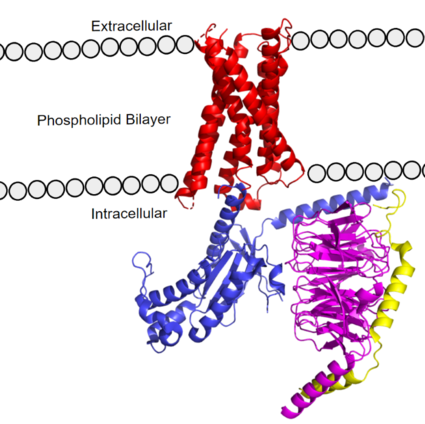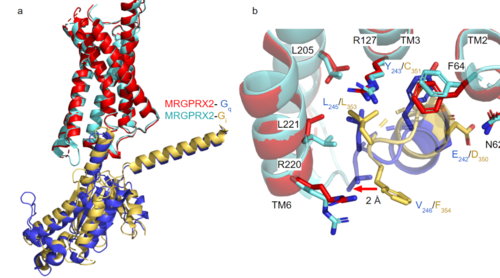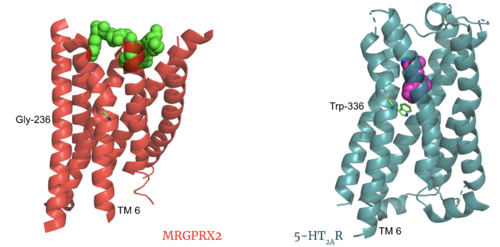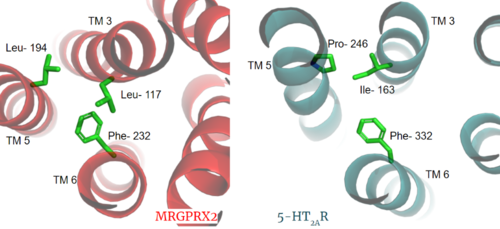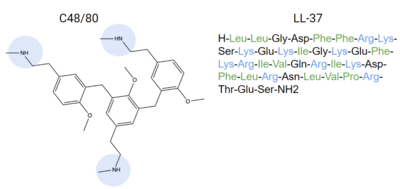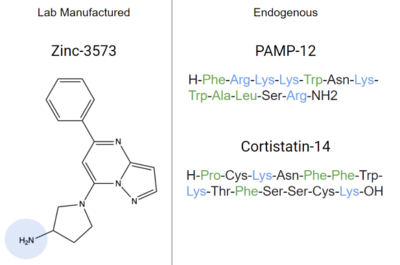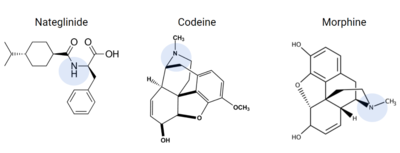Sandbox Reserved 1700
From Proteopedia
(Difference between revisions)
| Line 123: | Line 123: | ||
=== Before Activation === | === Before Activation === | ||
The culmination of different motifs observed in MRGPRX2 compared to other class A GPCRs leads to external membrane ligand binding. The MRGPRX2 GPCR undergoes a much smaller conformational change upon ligand binding compared to other Class A GPCRs due to surface level binding versus deep helix binding. This contrast is represented in the photo below to show the unbound and bound transmembrane proteins of MRGPRX2 and 5-HT2A. | The culmination of different motifs observed in MRGPRX2 compared to other class A GPCRs leads to external membrane ligand binding. The MRGPRX2 GPCR undergoes a much smaller conformational change upon ligand binding compared to other Class A GPCRs due to surface level binding versus deep helix binding. This contrast is represented in the photo below to show the unbound and bound transmembrane proteins of MRGPRX2 and 5-HT2A. | ||
| - | [[Image:Screen Shot 2022-03-282 at 6.59.44 PM.png|500px|center|thumb|'''Figure | + | [[Image:Screen Shot 2022-03-282 at 6.59.44 PM.png|500px|center|thumb|'''Figure 8.''' Overlay of unbound (transparent) and bound (opaque) transmembrane proteins of both MRGRPX2 (left) and 5-HT2AR (right).]] |
=== After Activation === | === After Activation === | ||
| Line 129: | Line 129: | ||
=== Clinical Relevance === | === Clinical Relevance === | ||
| - | Many medications commonly list chronic skin itching or inflammatory responses as side effects, such as nateglinide, an anti-diabetic drug <ref name= "Cao" />. Other drugs that have been known to trigger allergic reactions and even anaphylactic responses are opioids morphine or codeine<ref name= "Cao" />, which could explain anaphylactic responses to anesthetics seen in some patients<ref name="McNeil" />. Upon analysis of these drugs, they share many structural similarities that are known to bind to the sub-pockets in MRGPRX2, shown in | + | [[Image:Activating_drugs.png |400px|right|thumb|'''Figure 9.''' Common prescriptions that are tied to adverse itching side effects include nateglinide, morphine, and codeine. These drugs have structural similarities to known ligands for the MRGPRX2 receptor, and can lead to MRGPRX2 activation.]] |
| + | Many medications commonly list chronic skin itching or inflammatory responses as side effects, such as [https://pubchem.ncbi.nlm.nih.gov/compound/Nateglinide nateglinide], an anti-diabetic drug <ref name= "Cao" />. Other prescribed medications that list itching as a possible side effect are [https://pubchem.ncbi.nlm.nih.gov/compound/Atracurium#section=2D-Structure Atracurium], [https://pubchem.ncbi.nlm.nih.gov/compound/441290 Rocuronium], [https://pubchem.ncbi.nlm.nih.gov/compound/2764 Ciprofloxacin], and [https://pubchem.ncbi.nlm.nih.gov/compound/149096 Levofloxacin]<ref name="Navines-Ferrer">PMID:30072729</ref>, all of which are tied to MRGPRX2 activation. | ||
| + | Other drugs that have been known to trigger allergic reactions and even anaphylactic responses are opioids [https://pubchem.ncbi.nlm.nih.gov/compound/Morphine morphine] or [https://pubchem.ncbi.nlm.nih.gov/compound/5284371 codeine]<ref name= "Cao" />, which could explain anaphylactic responses to anesthetics seen in some patients<ref name="McNeil" />. Upon analysis of these drugs, they share many structural similarities that are known to bind to the sub-pockets in MRGPRX2, shown in '''Figure 9''', which is a possible explanation for the unwanted itch and inflammation responses produced in some patients when administering these drugs <ref name="McNeil" /><ref name= "Cao" />. | ||
Possible treatments for these unwanted side effects of drugs can be developed by understanding the mechanism of the MRGPRX2 receptor. Research on Cortistatin-14, an endogenous neuropeptide, has shown that it has antiinflammatory properties because of how it binds to the MRGPRX2 receptor <ref name= "Gonzalez-Rey">PMID: 16492802</ref>. Additionally, Osthole, an extract from Cnidium monnieri plants, also known as Monnier's snowparsley, demonstrates similar MRGPRX2 inhibition because of its structural similarity to many known ligands for this receptor, and could possibly be used as a treatment option for adverse allergic reactions to commonly prescribed drugs (donstralta). More research on MRGPRX2 can open the door for the development of drugs that avoid activation of the MRGPRX2 receptor, or possible treatments for excessive inflammation and allergic reactions. | Possible treatments for these unwanted side effects of drugs can be developed by understanding the mechanism of the MRGPRX2 receptor. Research on Cortistatin-14, an endogenous neuropeptide, has shown that it has antiinflammatory properties because of how it binds to the MRGPRX2 receptor <ref name= "Gonzalez-Rey">PMID: 16492802</ref>. Additionally, Osthole, an extract from Cnidium monnieri plants, also known as Monnier's snowparsley, demonstrates similar MRGPRX2 inhibition because of its structural similarity to many known ligands for this receptor, and could possibly be used as a treatment option for adverse allergic reactions to commonly prescribed drugs (donstralta). More research on MRGPRX2 can open the door for the development of drugs that avoid activation of the MRGPRX2 receptor, or possible treatments for excessive inflammation and allergic reactions. | ||
| Line 136: | Line 138: | ||
Because of how some drugs initiate an unwanted itch response, | Because of how some drugs initiate an unwanted itch response, | ||
| - | MRGPRX2 has been identified as a potential target for drugs either involved in the inflammatory response or to mediate drugs from causing an unwanted reaction such as | + | MRGPRX2 has been identified as a potential target for drugs either involved in the inflammatory response or to mediate drugs from causing an unwanted reaction such as |
| + | |||
| + | These drugs have similarly charged regions which may interact with sub-pockets 1 and/or 2. By binding these target drugs, MRGPRX2 can elicit or prevent a response to aid with itch-related side effects. | ||
[[Image:Screen Shot 2022-03-29 at 10.48.36 AM.png|500px|center|thumb|Schematic representation of cellular response]] | [[Image:Screen Shot 2022-03-29 at 10.48.36 AM.png|500px|center|thumb|Schematic representation of cellular response]] | ||
Revision as of 19:42, 16 April 2022
MRGPRX2 Human Itch G-Protein Coupled Receptor (GPCR)
| |||||||||||
References
- ↑ Tuteja N. Signaling through G protein coupled receptors. Plant Signal Behav. 2009 Oct;4(10):942-7. doi: 10.4161/psb.4.10.9530. Epub 2009, Oct 14. PMID:19826234 doi:http://dx.doi.org/10.4161/psb.4.10.9530
- ↑ Hauser AS, Attwood MM, Rask-Andersen M, Schioth HB, Gloriam DE. Trends in GPCR drug discovery: new agents, targets and indications. Nat Rev Drug Discov. 2017 Dec;16(12):829-842. doi: 10.1038/nrd.2017.178. Epub, 2017 Oct 27. PMID:29075003 doi:http://dx.doi.org/10.1038/nrd.2017.178
- ↑ 3.0 3.1 Porebski G, Kwiecien K, Pawica M, Kwitniewski M. Mas-Related G Protein-Coupled Receptor-X2 (MRGPRX2) in Drug Hypersensitivity Reactions. Front Immunol. 2018 Dec 20;9:3027. doi: 10.3389/fimmu.2018.03027. eCollection, 2018. PMID:30619367 doi:http://dx.doi.org/10.3389/fimmu.2018.03027
- ↑ 4.0 4.1 4.2 4.3 4.4 4.5 Dondalska A, Ronnberg E, Ma H, Palsson SA, Magnusdottir E, Gao T, Adam L, Lerner EA, Nilsson G, Lagerstrom M, Spetz AL. Amelioration of Compound 48/80-Mediated Itch and LL-37-Induced Inflammation by a Single-Stranded Oligonucleotide. Front Immunol. 2020 Sep 30;11:559589. doi: 10.3389/fimmu.2020.559589. eCollection, 2020. PMID:33101278 doi:http://dx.doi.org/10.3389/fimmu.2020.559589
- ↑ 5.0 5.1 5.2 5.3 5.4 5.5 5.6 McNeil BD, Pundir P, Meeker S, Han L, Undem BJ, Kulka M, Dong X. Identification of a mast-cell-specific receptor crucial for pseudo-allergic drug reactions. Nature. 2015 Mar 12;519(7542):237-41. doi: 10.1038/nature14022. Epub 2014 Dec 17. PMID:25517090 doi:http://dx.doi.org/10.1038/nature14022
- ↑ 6.00 6.01 6.02 6.03 6.04 6.05 6.06 6.07 6.08 6.09 6.10 Cao C, Kang HJ, Singh I, Chen H, Zhang C, Ye W, Hayes BW, Liu J, Gumpper RH, Bender BJ, Slocum ST, Krumm BE, Lansu K, McCorvy JD, Kroeze WK, English JG, DiBerto JF, Olsen RHJ, Huang XP, Zhang S, Liu Y, Kim K, Karpiak J, Jan LY, Abraham SN, Jin J, Shoichet BK, Fay JF, Roth BL. Structure, function and pharmacology of human itch GPCRs. Nature. 2021 Dec;600(7887):170-175. doi: 10.1038/s41586-021-04126-6. Epub 2021, Nov 17. PMID:34789874 doi:http://dx.doi.org/10.1038/s41586-021-04126-6
- ↑ 7.0 7.1 7.2 7.3 7.4 7.5 7.6 7.7 7.8 Yang F, Guo L, Li Y, Wang G, Wang J, Zhang C, Fang GX, Chen X, Liu L, Yan X, Liu Q, Qu C, Xu Y, Xiao P, Zhu Z, Li Z, Zhou J, Yu X, Gao N, Sun JP. Structure, function and pharmacology of human itch receptor complexes. Nature. 2021 Dec;600(7887):164-169. doi: 10.1038/s41586-021-04077-y. Epub 2021, Nov 17. PMID:34789875 doi:http://dx.doi.org/10.1038/s41586-021-04077-y
- ↑ Kamato D, Thach L, Bernard R, Chan V, Zheng W, Kaur H, Brimble M, Osman N, Little PJ. Structure, Function, Pharmacology, and Therapeutic Potential of the G Protein, Galpha/q,11. Front Cardiovasc Med. 2015 Mar 24;2:14. doi: 10.3389/fcvm.2015.00014. eCollection, 2015. PMID:26664886 doi:http://dx.doi.org/10.3389/fcvm.2015.00014
- ↑ Trzaskowski B, Latek D, Yuan S, Ghoshdastider U, Debinski A, Filipek S. Action of molecular switches in GPCRs--theoretical and experimental studies. Curr Med Chem. 2012;19(8):1090-109. doi: 10.2174/092986712799320556. PMID:22300046 doi:http://dx.doi.org/10.2174/092986712799320556
- ↑ Olivella M, Caltabiano G, Cordomi A. The role of Cysteine 6.47 in class A GPCRs. BMC Struct Biol. 2013 Mar 15;13:3. doi: 10.1186/1472-6807-13-3. PMID:23497259 doi:http://dx.doi.org/10.1186/1472-6807-13-3
- ↑ Gonzalez-Rey E, Chorny A, Robledo G, Delgado M. Cortistatin, a new antiinflammatory peptide with therapeutic effect on lethal endotoxemia. J Exp Med. 2006 Mar 20;203(3):563-71. doi: 10.1084/jem.20052017. Epub 2006 Feb, 21. PMID:16492802 doi:http://dx.doi.org/10.1084/jem.20052017
